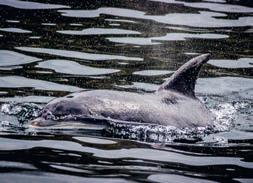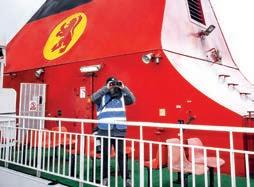
5 minute read
Wildlife


CRUISE IN COMPANY



A number of ferry routes in the Hebrides have a Wildlife Officer aboard during the summer months to point out, explain and record the creatures that can be viewed en route. Anna Bunney, from ORCA, explains to Donald Reid what can be seen on one of the best routes for sightings between Oban and Castlebay on Barra

'T he MV Isle of Lewis, which departs from Oban at lunchtime and arrives in Barra early evening, is a nice ship to watch from, and there's lots of time to be out with plenty of wildlife to enjoy. 'As soon as you're leaving Oban harbour, the first thing to see are seals, both common and grey seals, either swimming in the sea or hauled out on the rocks. When they're in the sea they do a behaviour called bottling, which is when they're dozing in the water with their heads sticking out. The Hebrides is a really important pupping area for seals because there are plenty of beaches and caves and nooks and crannies for the seals to give birth and bring up their young safe and sheltered from storms. Grey seals pup in October to December, with those really cute pups with fluffy

white fur – common seals are born around June-July time with their first adult coat. 'You can sometimes see cetaceans really close to Oban. The harbour porpoise is the only species of porpoise that we see in UK waters, and they can be seen all year round, and all across the Hebrides. You need a calm day to spot them: they're quite shy and they don't jump out of the water like dolphins. They only grow up to about one and a half metres long, so they're quite small. They appear in pods up to about six in number and just quickly surface to breathe, when you see their equilateral triangle-shaped dorsal fin, and they'll surface three or four times. They're also a good species to see from land, particularly from headlands where there are tidal currents mixing. 'Coming into the Sound of Mull, you can get quite a lot of bottlenose dolphins here: we think there might be a resident population of these dolphins around Mull. We're at the northernmost extreme of this species' global range, and they're most frequently seen in inshore waters around headlands and bays. 'We're not always just looking into the sea, but also into the sky, and you have the chance to see the world's fourth-largest eagle, the white-tailed sea eagle. Golden eagles are regularly spotted in the skies around Mull as well. There are lots of seabirds thanks to the amount of food that's available. Sand eels are particularly important for puffins, and the health of the bird population depends on the fish in the area. The biggest seabird colony is on Lunga, with puffins, razorbills, kittiwakes, guillemots and fulmars, and the rare corncrake also nests there. 'As the ship heads out of the Sound of Mull into the Sea of the Hebrides, you come past the northern tip of Coll. There are quite a lot of changes in water depth here and many currents mixing. In recent years we've seen hundreds of common dolphins here – once we had over 250 dolphins – and you can see nursery pods of mothers with calves. The dolphins come to play in the bow wave and the wake of the ship. They're quite energetic and acrobatic, and they also have really beautiful patterns on their flanks, yellow at the front and grey at the back, so they're quite easy to identify. The crew on the MV Isle of Lewis say that they see them all the time there. Another route that's really good for sighting common dolphins is the Uig to Lochmaddy ferry, about 20 minutes out of Uig. 'The warming waters of the Gulf Stream cause plankton blooms in the summer, and this attracts huge numbers of basking sharks to the Hebrides, especially around Mull, Coll and Tiree. Minke whales are pretty well-known in the area: they're one of the smallest baleen whales, so unlike dolphins and porpoises they don't have teeth but have these thick keratin brushes hanging from their top jaw, which they use to filter small fish from the water. They're very slender and streamlined, and they grow to about ten metres long. You know you've seen a minke whale if you see quite a small dorsal fin two-thirds of the way along the back; if you see quite a big dorsal fin in the middle of the body, then that's usually a dolphin. 'If you're super-lucky you might see more mobile species such as the orca (or killer whale) which can travel hundreds of miles in a day. There's a west coast community of eight killer whales which has become quite famous. There are also migratory species such as humpback whales – often they're much further offshore, but sometimes they do take a route through the islands. 'And then it's the same on the way back from Barra to Oban. The ship leaves early in the morning and gets back just after midday, so again you get a good five hours of watching time going across a number of different habitats.'
WILDLIFE MINI-CRUISES
The presence of ORCA Wildlife Officers on certain ferry routes are advertised in advance through social media channels: search for the hashtag #HebridesWildlifeOfficer on ORCA’s (@ORCA_ web) and CalMac’s Twitter feed. In particular, look out for Wildlife Officers aboard the MV Clansman route from Oban-Coll-TireeBarra-Oban in one day (departing around 7am, returning around 9pm) on the last Wednesday of each month. On board, listen out for announcements about the presence of a Wildlife Officer or look out for them on the outside decks.










